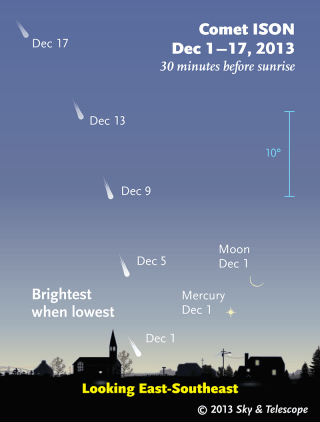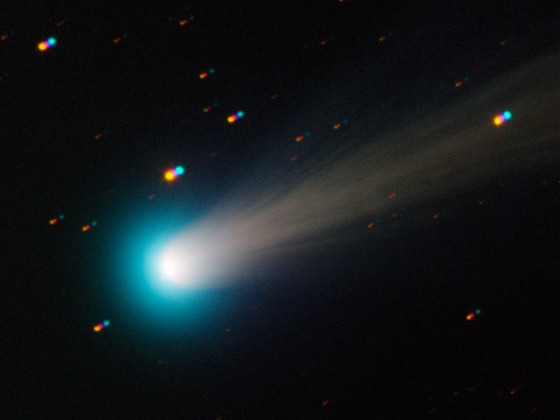14 minutes ago
Experts gives Comet ISON only a 30 percent chance of surviving its crucial Thanksgiving Day encounter with the sun. Or maybe 40 percent. Whatever the odds, scientists say what some have called the 'comet of the century' has already lived up to their expectations.
But will it live up to yours? We should find out on Thursday, during a series of webcasts you can tune into while waiting for Thanksgiving dinner.
You won't be able to see the comet flaring in the sky on Thursday. Instead, leave the comet-watching job to NASA's sun-watching probes, including the Solar Dynamics Observatory, the Solar and Heliospheric Observatory and the twin STEREO probes.
'If people want to observe it then, we strongly urge them to sit down in front of their computers and bring up the latest images .... and they can watch it from the comfort of their own home without any risk,' said Naval Research Laboratory astronomer Karl Battams, one of the members of the NASA Comet ISON Observing Campaign. 'We certainly don't want people to go outside and start waving binoculars and telescopes in the region of the sun, because that's extraordinarily dangerous.' That's because anytime you're looking toward the sun, you run the risk of eye damage.
If ISON survives, or even if it breaks up spectacularly, it could be a can't-miss naked-eye sight by the first or second week of December - a 'beautiful paintbrush swath on the sky,' in the words of Carey Lisse, the astronomer at Johns Hopkins University's Applied Physics Laboratory who heads up the comet campaign.

Take special note of the 'ifs.' Because ISON is an icy comet making its first visit to the inner solar system from the far-flung reaches of the Oort Cloud, even the experts are finding it hard to predict exactly what will happen. When Russian astronomers discovered ISON in September 2012, some observers hoped it would turn into the comet of the century. Last week, the prospects looked good for its survival. On Monday, not so good. And on Tuesday, scientists' hopes brightened again, along with the comet.
'I personally think the comet may have actually fallen apart a little bit, but I think there's mostly a big chunk still there,' Lisse told reporters. 'I think it's going to make it to the sun. I think we're going to have a fantastic series of images from SDO, STEREO and SOHO. I think we're going to see beautiful, incoming streaking comets, and they're going to flare up and burn away. ... As a betting man, as a poker player, I think it's not going to survive solar passage. If you want me to put odds on it, maybe it's a 30 percent chance that it'll make it out around the sun and back to Earth.'
Lisse later revised his bet to 40 percent, taking into account the possibility that ISON could break up in the same way that Comet Lovejoy did in late 2011. Even though Lovejoy didn't survive intact, it flared up to create a days-long spectacle for Southern Hemisphere observers.
This time, Northern Hemisphere observers have the ringside seats: After Thursday's swing around the sun, ISON would be best-placed for viewing in eastern skies just before sunrise. Eventually, skywatchers could see it in western skies just after sunset as well. During December, ISON would get progressively higher in the sky - but progressively dimmer as well.
Scientific starWhether or not ISON survives, the comet 'has been a true star,' Battams said. 'It's already been a huge victory for science.'
Never before has a pristine comet from the Oort Cloud come so close to the sun, with the eyes of so many space probes focused on it. The Hubble, Chandra, Swift and Spitzer space telescopes have been watching, along with NASA's Mars Reconnaissance Orbiter, the airborne SOFIA observatory, the Deep Impact spacecraft and the Messenger orbiter at Mercury.
Lisse said ISON is worth all the effort because such comets are thought to be leftovers from the very beginnings of the solar system. 'It's a dinosaur bone of solar system formation,' he explained.

E. Jehin / TRAPPIST / ESO
ISON is thought to have been jarred loose from its usual hangout in the Oort Cloud by the subtle gravitational effect of a passing star, and has been en route to its solar encounter for millions of years. Initially, scientists thought ISON was bigger than the average comet because of its large amount of outgassing, but Lisse said improved estimates suggest that its nucleus is no wider than three-quarters of a mile (1.2 kilometers) - which puts it on the smallish side. 'Most likely it was instead very precocious,' Lisse said.
ISON appears to have an unusual amount of frozen carbon dioxide, which accounts for its greenish glow as it heats up. 'It is looking like carbon dioxide may be a very fundamental molecule in the early solar system,' Lisse said. The comet is also rapidly evolving: Initial observations suggested that it was not rotating, but ISON's nucleus now appears to spin around every 10 hours, probably due to the dynamics of its outgassing.
Battams said scientists are also learning 'a tremendous amount' from the interaction of the comet's tail with the solar wind - that is, the stream of electrically charged particles emanating from the sun. ISON's tail is acting 'like a windsock at an airfield.'
The peak time for scientific observations will come when ISON streaks within 730,000 miles (1.2 million kilometers) of the sun's surface at 1:44 p.m. ET on Thursday, hitting a top speed of 780,000 mph (350 kilometers per second). And thanks to online opportunities, you'll be able to watch what happens along with the scientists.
How to watch online NASA presents a Google+ Hangout from 1 p.m. to 3:30 p.m. ET Thursday, featuring imagery from the Solar Dynamics Observatory and commentary from SDO's mission control. The hangout also will be carried live on NASA Television and the agency's website. Panelists include solar physicists C. Alex Young and W. Dean Pesnel, comet scientist Karl Battams and 'Bad Astronomy' blogger Phil Plait. Views from the Solar Dynamics Observatory will also be posted on NASA's Comet ISON Perihelion website. Check http://www.nasa.gov/ison for still more images. There's also a Comet ISON Flickr photo pool, and SpaceWeather's ISON gallery. Comet ISON is the subject of post-perihelion Google+ Hangouts scheduled for noon ET Dec. 2 to Dec. 6 in association with the Comet Festival South Bend. The Planetary Society's Emily Lakdawalla points to those and other ISON-related events. If ISON survives, the Slooh virtual observatory is gearing up to follow the comet's progress via telescopes in Arizona, South America and the Canary Islands. A schedule of live broadcasts will be set up if and when the comet comes into view. 'The uncertainty in how ISON will appear is part of the fun. ... We could be in for a true spectacle, or a big zero, and Slooh will be prepared to show the world which of these two doors will open for us,' astronomer Bob Berman said in an emailed statement. More about Comet ISON: For updates on Comet ISON, keep tabs on Space.com, the Comet ISON Observing Campaign, Hubblesite's ISONBlog, SpaceWeather.com and the websites for Astronomy Magazine and Sky & Telescope. On Twitter, follow @ISONUpdates, @CometISONnews, @CometISON2013, @SungrazerComets and @Cosmos4u. Alan Boyle is NBCNews.com's science editor. Connect with the Cosmic Log community by 'liking' the log's Facebook page, following @b0yle on Twitter and adding the Cosmic Log page to your Google+ presence. To keep up with Cosmic Log as well as NBCNews.com's other stories about science and space, sign up for the Tech & Science newsletter, delivered to your email in-box every weekday. You can also check out 'The Case for Pluto,' my book about the controversial dwarf planet and the search for new worlds.
{ 0 comments... Views All / Send Comment! }
Post a Comment